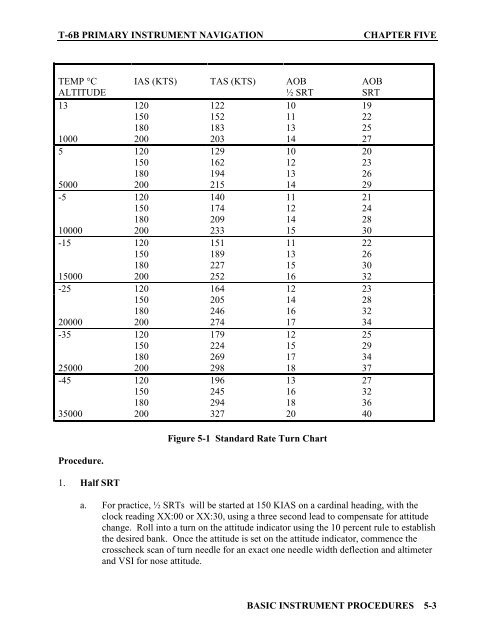Flight Training Instruction - Cnatra - U.S. Navy
Flight Training Instruction - Cnatra - U.S. Navy
Flight Training Instruction - Cnatra - U.S. Navy
You also want an ePaper? Increase the reach of your titles
YUMPU automatically turns print PDFs into web optimized ePapers that Google loves.
T-6B PRIMARY INSTRUMENT NAVIGATION CHAPTER FIVE<br />
TEMP °C IAS (KTS) TAS (KTS) AOB<br />
AOB<br />
ALTITUDE<br />
½ SRT SRT<br />
13 120 122 10 19<br />
150 152 11 22<br />
180 183 13 25<br />
1000 200 203 14 27<br />
5 120 129 10 20<br />
150 162 12 23<br />
180 194 13 26<br />
5000 200 215 14 29<br />
-5 120 140 11 21<br />
150 174 12 24<br />
180 209 14 28<br />
10000 200 233 15 30<br />
-15 120 151 11 22<br />
150 189 13 26<br />
180 227 15 30<br />
15000 200 252 16 32<br />
-25 120 164 12 23<br />
150 205 14 28<br />
180 246 16 32<br />
20000 200 274 17 34<br />
-35 120 179 12 25<br />
150 224 15 29<br />
180 269 17 34<br />
25000 200 298 18 37<br />
-45 120 196 13 27<br />
150 245 16 32<br />
180 294 18 36<br />
35000 200 327 20 40<br />
Procedure.<br />
1. Half SRT<br />
Figure 5-1 Standard Rate Turn Chart<br />
a. For practice, ½ SRTs will be started at 150 KIAS on a cardinal heading, with the<br />
clock reading XX:00 or XX:30, using a three second lead to compensate for attitude<br />
change. Roll into a turn on the attitude indicator using the 10 percent rule to establish<br />
the desired bank. Once the attitude is set on the attitude indicator, commence the<br />
crosscheck scan of turn needle for an exact one needle width deflection and altimeter<br />
and VSI for nose attitude.<br />
BASIC INSTRUMENT PROCEDURES 5-3
















